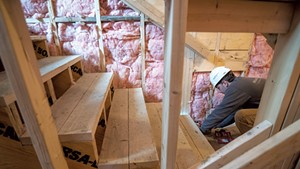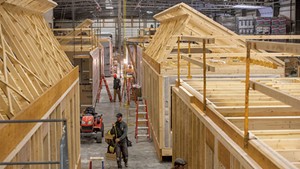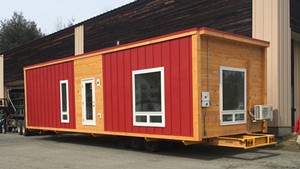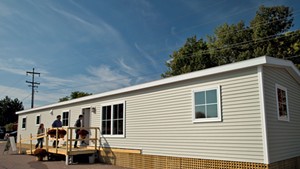
- James Buck
- Dustin Hendy of Laurie's Certified Construction
Construction prices have spiked about 33 percent in Vermont since last year, driving up the price of new homes and remodeling projects — and squelching the development of middle-income housing.
It now costs about $500,000 to build a modest apartment or small home, compared to about $370,000 in 2022, according to the Vermont Housing Finance Agency, an affordable housing organization that finances loans for lower- and middle-income Vermonters. The price of land, lending, labor and materials has been climbing steadily since 2019, but the pace of the increase accelerated in the past 12 months.
As a result, private developers are focusing on building high-end homes, where they can get a larger return on the higher prices they're paying for materials and labor. And affordable housing developers are scaling back their projects to make them work financially.
While the legislature has allocated millions of dollars in recent years to relieve Vermont's long-running housing shortage, housing agencies say the money is not building as many apartments as they had hoped.
"We've had this great infusion of federal and state money, but some of that is getting chewed up by this increase in costs," said Kathy Beyer, senior vice president for real estate development at the affordable housing developer Evernorth. "You might have been able to build a 100-unit [development] before; now you can only build 80."
The squeeze has developers looking at another alternative: importing modular housing units from out-of-state factories. Thom Lauzon, a real estate developer in Barre who owns dozens of properties, said he's talking to a modular company in Québec about building an 80-unit apartment building. The move would save 5 to 10 percent in construction costs, he said, and quicken the building process.
"If we really want to change things over the next two or three years, we have to embrace the efficiency of modular," Lauzon said. "If we can't bring the contractors to the project, then we have to bring the project to the contractors."
It's been tough to build homes in Vermont for years, even decades. Simple geography limits the space that is available for new homes; land conservation, community opposition and environmental regulations can make building more difficult and more expensive.
July's floods presented a stark reminder of how vulnerable Vermont's river valleys are to devastating water damage. While state policy is geared to steer builders away from hillsides, planners are taking another look at the traditional emphasis on building in existing village centers, often by rivers. That would further narrow the options for developers.
Builders say much of the most recent construction price increase, nationally and in Vermont, is linked to high interest rates and accelerating pay increases for people who work in the trades. Compensation for carpenters, plumbers and others who are vital to home construction increased by 19 percent between 2018 and the end of 2022, according to Kate Stephenson, a cofounder of HELM Construction Solutions, a consulting firm based in Montpelier and Brattleboro. HELM surveyed 50 companies in New England to get its latest wage data.
"The builders that we work with, in general, are busier than they have ever been before and have work lined up far in advance," said Stephenson, who works with builders around the country. "The folks I am working with are charging more, but their costs are going up."
While the increase is bad news for people who need an affordable home, Stephenson noted, it's good news for unskilled workers who just a few years ago were getting $14 to $16 an hour on the jobsite. Construction companies are hiring unskilled workers at $18 to $20 now.
"It shows that these jobs in the trades are important and people can make a good living in them," said Stephenson, who helps her clients find ways to add health insurance, paid time off and other benefits to positions that have traditionally lacked them. "I see this increase in compensation as really good."
Many Vermont builders said they are starting skilled carpenters at around $25 an hour now, almost twice as much as they were paying 10 years ago. For the skilled workers who are most difficult to find, the pay has jumped to around $30 an hour, according to several builders.
Dixie O'Connor, a remodeler and builder who is president of the Vermont Builders & Remodelers Association, is paying her carpenters $31 an hour plus benefits.
"We have to tack on overhead," O'Connor said. A few years ago, she would have charged a customer $50 an hour for the carpenter's time; now she charges $60 to $90.
As a volunteer organization, Central Vermont Habitat for Humanity gets a lot of its labor, even skilled labor, for free. But a duplex it's building in Randolph is turning out to be the most expensive project the central Vermont group has ever built, said Zachariah Watson, the local organization's executive director. The downtown site, between two existing homes, would typically be an easy place to build, but it requires costly water and sewer lines, as well as a new power pole. Watson said it's difficult to find an uncomplicated building lot that meets the organization's needs.
"Even the infill lots that are available are challenging right now," Watson said. "All the easy lots have been bought up."

- James Buck
- Dustin Hendy talking with a homeowner
Many of the factors driving up construction costs are national or global in scope. Vermont builders import fixtures, drywall and other materials from as far away as China. And interest rates play a key role in the cost of housing for buyers who need a mortgage. The prime lending rate, which hit a low of 3.5 percent in 2020, is now 8.5 percent.
"Refinancing homes or getting loans or whatever is so expensive that a lot of people are changing their minds about doing their projects at all right now," said Laurie Goldsmith, who owns Laurie's Certified Construction in Colchester.
Goldsmith said some clients have told her that they are waiting to build until prices go back down.
"But everyone has been saying that since COVID hit," Goldsmith said. "And here we are, three years later, and barely anything has come down."
Some Vermont developers note modular building gets around the labor shortage, too. Modular units are built in factories, often in states with lower salaries than in Vermont, and shipped in pieces to the site to be assembled.
The units are painted and finished in the factory, often down to the installation of towel racks in the bathrooms, saving those labor costs on the other end. Unlike mobile homes, which travel to the site completed and on their own chassis, modules can be assembled on-site into small or large homes, duplexes, hotels and apartment buildings.
The Vermont Housing & Conservation Board, a state affordable housing developer, has purchased some modular units as part of its wide-reaching real estate portfolio, which includes hundreds of units of multifamily housing and some single-family homes.
After 2011's Tropical Storm Irene, VHCB helped create Vermod, a company in Wilder that makes energy-efficient modular homes, as a way of supplying high-quality, lower-cost homes. But at $200,000 to $400,000 per unit, even Vermod has become too expensive for VHCB's affordable housing program, said Gus Seelig, the group's executive director. Last year, VHCB started working with a company in Maine called Champion Homes that makes energy-efficient mobile and modular homes for about $30,000 less per unit than Vermod.
VHCB has never relied heavily on modular homes before, but Seelig expects that building homes in factories, instead of on-site, will soon become much more common. He's also in talks with a large modular home company in New York.
"They're at a whole different scale from Vermod or the company we're working with in Maine, and scale matters here," Seelig said. "If you save 10 percent on a $400,000 build, that's real money."
Watson, the Habitat for Humanity director, is considering modular homes for a development of duplexes that his organization is planning in Montpelier. He's working with a company called Bensonwood in New Hampshire.
"It's going to look like all the other houses on the street, except it's a duplex instead of single-family," he said of one building.
An engineer and developer named Aron Shea is planning to build five four-unit townhomes on a former farm in Waitsfield using modulars. His would travel from a company called Signature Building Systems outside Scranton, Pa.
"There are tons of good options for modular all over the country," Shea said. "Why would we ever build it on-site when we can have someone else build it in a controlled environment?"
Despite the high cost of materials and labor, builders are still busy; many reported that they're booking jobs for late next year or early 2025. But for people who don't have half a million to spend on a small home, the cost crisis means canceling planned moves, bunking with family or friends, turning down jobs because there's nowhere to live nearby, or staying put in substandard housing.
Christine Bourque, who lives with her husband and two daughters on a farm in Grand Isle, turned to GoFundMe to help raise the $65,000 she needed to finish paying for a modular home that will get her family out of the 1981 mobile home they've occupied since they bought their land in 2004.
"Our roof is leaking, the windows are broken, the wind blows through our house, it is too small," Bourque said in her plea, which hit its fundraising goal.
"Our modest, one-floor, 1400 sq ft home costs over $500k to build," Bourque wrote. "Wait what? Yes, that's true. Prices are soaring and the average small farmer can not afford it or anyone else."
Someone clearly can afford it. Goldsmith said about 80 percent of the calls she gets for remodeling jobs are from people who have moved from out of state.
"They're working from home," she said, "and they're the ones who have the money."













Comments
Comments are closed.
From 2014-2020, Seven Days allowed readers to comment on all stories posted on our website. While we've appreciated the suggestions and insights, right now Seven Days is prioritizing our core mission — producing high-quality, responsible local journalism — over moderating online debates between readers.
To criticize, correct or praise our reporting, please send us a letter to the editor or send us a tip. We’ll check it out and report the results.
Online comments may return when we have better tech tools for managing them. Thanks for reading.